________________
SVASTI - Essays in Honour of Prof. Hampa Nagarajaiah
Influence of Old Kannada on Tamil-Brāhmī Inscriptions The present study has brought to light the hitherto unsuspected influence of Old Kannada on the Tamil-Brāhmi inscriptions from a period (ca. 2nd century B.C.-4th century A.D.) anterior to the earliest known Kannada inscriptions and literature, especially from Sittannavasal (ca. 1st century B.C.), Tirupparankunram (ca. 1st century A.D.), Edakal (ca. 3rd century A.D.) and Nekanurpatti (ca. 4th century A.D.). Some of the more interesting lexical items and grammatical usages showing the influence of Old Kannada are listed below. Lexical items
Eruminātu is the same as LT erumainātu, the Mysore region (mahisha-mandala) of Karnataka. The word erumi (Ta. erumai, Ka., Tu. erme, Go. ermi) 'buffalo' appears to preserve an ancient dialectal form. kavuti is the personal name of the nun who is described in the inscription as born in a village in erumināļu. cf. Ka. gavudi, gaudi 'feminine of gauda, wife of a gāvumda, wife of a village officer'. pocil 'entrance'. The expression occurs as part of the place name tenku-ciru-pocil which appears to be the same as ten-ciru-vāyil, mentioned in the later Tamil inscriptions of the region as the name of the nātu (territorial division) immediately to the east of the hill at Sittannavasal. pocil is not attested in Tamil and appears to be related to Ka. hosilu (< *posil) 'entrance'. cf. also To. pos 'entrance'. tāyiyaru 'mother' (honorific). This is clearly a loanword from Kannada. The word occurs in New Kannada but is not attested in Old Kannada. However, as this inscription from Nekanurpatti is assigned to ca, 4h century A.D. on palaeographic evidence, we have to regard tāyiyaru as an Old Kannada word which existed in the spoken language but was not attested in contemporary records. Personal names and honorifics Personal names like āy(c)ca and polāl (a), and the suffixed honorifics anni, alp)paand a(y)yan / aiyan appear to be more at home in Old Kannada onomastics. Grammatical usages -ā, occurring as the genitive suffix in some inscriptions is not attested in Tamil, but occurs in Old Kannada inscriptions where it is regarded as more ancient than -a. -u, the euphonic suffix to stems ending in liquid consonants (e.g., ūru 'village') occurring mostly in the later inscriptions, is not attested in Old Tamil and appears to be due to the influence of Old Kannada, even though the suffix is attested in Kannada inscriptions only from the middle period (ca. 8th century A.D.). Spread of Jainism from Karnataka The presence of Old Kannada elements in the Tamil-Brāhmī inscriptions corroborates the traditional account of the spread of Jainism from Karnataka into the Tamil country.




